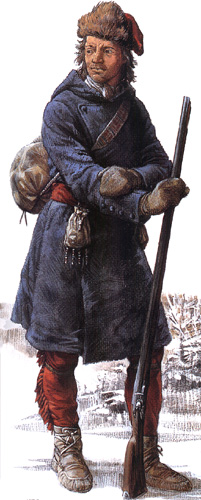 There were three separate military organizations in New France. The milice (militia) comprising all able-bodied men between sixteen and sixty, was organized in compagnies and commanded by captains of the militia selected by the governor general from among the habitants. The Troupes de la Marine were independent companies of regular troops raised in France to serve in the naval ports and the colonies. They came under the minister of the marine, not the minister of war. During the Seven Years' War several regiments of regular troops were sent to Canada. They were known as Troupes de Terre because many of the regiments derived their names from French provinces, for example Regiment de Languedoc and Regiment de Guyenne.
There were three separate military organizations in New France. The milice (militia) comprising all able-bodied men between sixteen and sixty, was organized in compagnies and commanded by captains of the militia selected by the governor general from among the habitants. The Troupes de la Marine were independent companies of regular troops raised in France to serve in the naval ports and the colonies. They came under the minister of the marine, not the minister of war. During the Seven Years' War several regiments of regular troops were sent to Canada. They were known as Troupes de Terre because many of the regiments derived their names from French provinces, for example Regiment de Languedoc and Regiment de Guyenne.
 In the country districts a uniquely Canadian official emerged early in the French regime and quickly became indispensible. This was the capitain of the Militia. In 1669, Governor Remy de Courcelles received orders from the king to organize the Canadian settlers into military companies and to see to it that they received military training. Militia companies, each with a captain in command and subordinate officers, were established in both the towns and the country parishes
In the country districts a uniquely Canadian official emerged early in the French regime and quickly became indispensible. This was the capitain of the Militia. In 1669, Governor Remy de Courcelles received orders from the king to organize the Canadian settlers into military companies and to see to it that they received military training. Militia companies, each with a captain in command and subordinate officers, were established in both the towns and the country parishes
and quickly proved their worth in all the colony's wars. These captains of the militia were appointed by the governor general and of necessity had to be men respected by the habitants of their respective parishes, but their main function in peacetime was to act as sub-delegates of the intendant and as local police officers. They served as the vital link between the administration and the people,
making the desires or complaints of the people known to the officials, who were usually responsive. In this ingenious way the seigneurs were prevented from becoming too powerful; they were neatly bypassed in the chain of authority, and when certain of the seigneurs attempted to have militia captains made subordinate to them, the minister immediately instructed the governor to order them to desist. Like the English justice of the peace, the militia captain received no pay or fees; the prestige and status of the office sufficed.
 In the country parishes, the habitants held frequent assemblies to decide local matters, usually, if not as a rule, at the behest of the intendant or his deputy. But the people at large were not permitted, under any circumstances to call assemblies on their own to discuss public issues. They could make their views known to the militia captain who would pass the information on to the intendant. It then rested with him to decide what actions to take. Although every subject had the right to present a petition to the king, and some at least had their requests granted, the circulation of petitions to gather signatures was strictly forbidden. Such petitions and unsanctioned public meetings were regarded as seditious.
In the country parishes, the habitants held frequent assemblies to decide local matters, usually, if not as a rule, at the behest of the intendant or his deputy. But the people at large were not permitted, under any circumstances to call assemblies on their own to discuss public issues. They could make their views known to the militia captain who would pass the information on to the intendant. It then rested with him to decide what actions to take. Although every subject had the right to present a petition to the king, and some at least had their requests granted, the circulation of petitions to gather signatures was strictly forbidden. Such petitions and unsanctioned public meetings were regarded as seditious.
The above is taken from The Canadian Frontier 1531 - 1760 by W.J. Eccles.
What makes the above significant to our family genealogy is that two of our ancestors served as
 Captain of the Militia, both in the Seigneury of Batiscan.
Captain of the Militia, both in the Seigneury of Batiscan.
 Nicolas Rivard dit Lavigne (1617 - 1701) was the first to hold that post in Batiscan. He
Nicolas Rivard dit Lavigne (1617 - 1701) was the first to hold that post in Batiscan. He
 mediated a land dispute over badly surveyed land concessions in the seigneury; it
mediated a land dispute over badly surveyed land concessions in the seigneury; it
 lasted several years. He served in this important position until his 81st birthday.
lasted several years. He served in this important position until his 81st birthday.
 Joseph Guillet dit St Marc (1700 - ?)
Joseph Guillet dit St Marc (1700 - ?)


